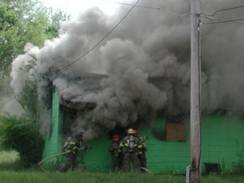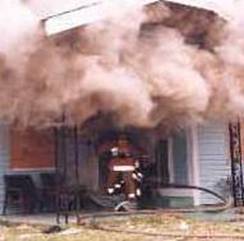

|
“Our Mission Is To Provide Quality Public Service, Public Education, and Professional Emergency Response” |
|
Monroe Fire Department 1810 Martin Luther King Blvd Monroe, LA (318)329-2474 Jimmie R. Bryant, Fire Chief |
| EMSNetwork Latest News |



|
International Association of Fire Chiefs |
|
International Association of Firefighters |

|
National Association For Search and Rescue |

|
National Association of Emergency Medical Technicians |

|
National Fire Fighter Near-Miss Reporting System |

|
Fire Attack Upon arrival at the structure fire, the Company Officer on the engine company, along with the senior private, or “side man” initiates the fire attack using standard 1 3/4” (“inch and three-quarter”) handline, one of three that are designated for fire attack, and have a reach of 200 feet.
The Incident Commander, Company Officer, or the person leading the attack, has to determine if an interior or exterior attack will be used. This decision is based upon the amount of fire showing as compared to the size of the structure, the perceived stability of the roof and supporting construction, and the presence of any signs of a “backdraft.”
A “backdraft” is a state of combustion where objects in an enclosed room, one where all windows and doors are shut, have burned freely and are to the point where sufficient heat as well as sufficient fuel (contents of the structure) are present, but the combustion has consumed all of the oxygen inside the enclosed room. Firefighters watch for the signs of a backdraft before entering a smoke-filled structure. One of these signs is discolored, usually yellow-gray or yellow-green instead of dark grey or brown. Another sign is small amounts of smoke exiting small openings, and then being drafted back into the opening in reverse.
If a backdraft is not recognized, and a door is opened or a window is broken, this will give the smoldering fire oxygen, which is the final component it needs to suddenly erupt in a violent outburst of fire and superheated gases, usually followed by the fire extinguishing itself momentarily, leaving more smoldering objects. Backdrafts have been known to blast firefighters violently backward, propelling them through the air as a result of the sudden violent release of superheated gases.
If the backdraft is recognized in advance, then the Incident Commander will order vertical ventilation, where the Ladder Company will position themselves on the roof directly as close as possible over the seat of the fire and, using a chain saw, axe, or K-12 saw, will create an opening through the roof for the superheated gases to escape through the opening, thereby greatly lowering the temperature in the affected room.
If the person leading the attack perceives the structure to be stable enough for an interior attack, and if an interior attack has not been declared contraindicated by the incident Safety Officer, then he or she will enter the structure at an entrance where the fire can be attacked from the unburned area to the burned area, to insure the fire is stopped at this point. If the fire is attacked from the burning area, it could be “pushed” from the burning area to an unburned area of the structure, causing more fire and smoke damage.
If an exterior attack is ordered, then it is usually because the structure is perceived to be too unstable for an interior attack. In these instances, firefighters may position themselves in exterior windows and doors and attack the fire safely from the outside.
All persons entering a hazardous area, such as inside or outside adjacent to a structure fire, are required to wear a self-contained-breathing-apparatus (SCBA). This provides approximately 20-45 minutes of breathable air for the firefighter during the interior attack.
|
|
Fire Suppression—The Life Cycle of a Structure Fire Response |
|
Next: Ventilation |


